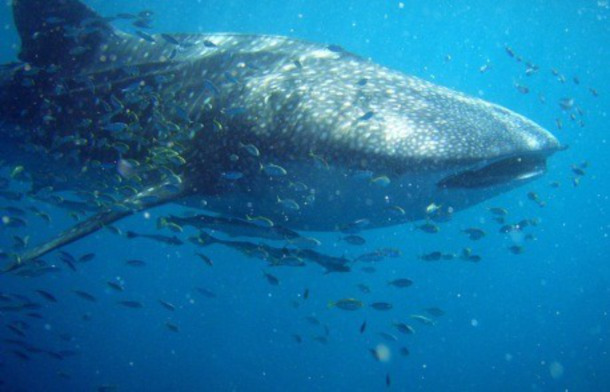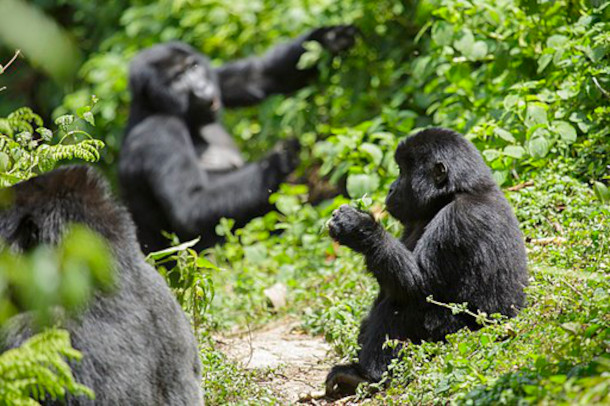Extreme Wildlife Loss
Air Date: Week of November 11, 2022

Sea turtles in Palawan, the Philippines. (Photo: David Reynolds, Unsplash, public domain)
This year’s Living Planet Report from the World Wildlife Fund and Zoological Society of London shows a nearly 70% decline in wildlife populations since 1970 due to habitat loss, over harvest, pollution, climate stress and more. The climate crisis will keep putting even more pressure on wildlife but there are also signs of improvement and hope. Host Steve Curwood discusses the report and how we can restore the loss with WWF Global Freshwater Lead Scientist Jeff Opperman.
Transcript
CURWOOD: It’s Living on Earth, I’m Steve Curwood.
The latest Living Planet Report from the World Wildlife Fund and Zoological Society of London documents a nearly seventy percent depletion of wild animals with backbones over just the past 50 years. The report comes as the UN Convention on Biological Diversity prepares for its fifteenth conference of its parties or COP in Montreal, Canada at the beginning of December. So, for the story behind this alarming assessment of wildlife loss we turn now to one of the report’s authors, Jeff Opperman, the global lead scientist for freshwater for the World Wildlife Fund. Welcome to Living on Earth Jeff!
OPPERMAN: Great, thanks. It's great to be here and really looking forward to talking about this important topic and what we can do about it.
CURWOOD: So, Jeff Opperman, tell us your findings in this year's Living Planet Report. How different is it from the report of two years ago?
OPPERMAN: Well, the headline finding is that there's been a 69% decline in monitored vertebrate populations of wildlife. So vertebrates are mammals, birds, reptiles, fish, amphibians. The Living Planet Report includes what's called the Living Planet Index. And that is 32,000 distinct populations of vertebrates that have been monitored for their abundance over time. These are drawn from across 5,000 different species, and it combines them into a number that reflects the overall trend, the overall pattern of wildlife on Earth.
CURWOOD: And over what period of time are we talking about losing this 69%?
OPPERMAN: So the LPI, that Living Planet Index, number of a 69% average decline is from 1970 until 2018. There's a little bit of a lag in the data so that what we release this year, it goes up to 2018. It's about 50 years. You know, I was born in 1971. This number is reflecting the trend since 1970. So basically, just in the time that I've been on Earth, the Earth has seen this average decline of about two thirds of these wildlife populations.

A whale shark as photographed in Ningaloo Reef in Australia. (Photo: brittgow, Flickr, CC-NC 2.0)
CURWOOD: And we're talking about things with backbones, from fish to deer to birds, but not insects, which I guess are also seeing a fairly substantial decline.
OPPERMAN: A lot of it has to do with the fact that it's a monumental task of integrating all these datasets. As I said, 32,000 distinct populations and integrating them to try to see these trends over time, and to fill in the gaps and to recognize what types of species we have fewer data from what regions, you know. Until recently, we had a lot less data from South America, and we've been working to fill that gap. The problem with insects is, rather than filling gaps, it would be mostly gaps. We just simply don't have the same degree of tracking over time of insect abundance. The studies that have been done in specific areas are quite alarming. And I do think that the scientists who manage this Living Planet Index are trying to collect insect data to do it in the same way.
CURWOOD: So you're talking about, for lack of a more elegant word, the biomass of the wildlife population? To what extent is this related to extinction?
OPPERMAN: The real data that we're talking about here is abundance of populations. If you were monitoring a population of whale sharks in the Caribbean, and there were 8,000 of them in 1980, and then there were 4,000 of them in 1990, that those would be data points that could go into the Living Planet Index, because it would be a population of whale sharks, and that would be one of the 30,000. And then there could be another population of whale sharks in the Indian Ocean, also tracking the abundance. So the real essence of the LPI is to take all those abundance, which also reflect biomass and just how many animals are out there in these different populations. Now, it's not quite the same thing as extinction. Extinction is fairly binary. And there are indices that track extinction or ways of tracking the number of species have gone extinct. But as I just said, that is very binary: a species is either still around or goes away, in terms of being an indicator. In some ways, it's not very useful indicator, because once a species is extinct, that's it. It's better to be tracking the status of species, the status of populations, are they declining. And of course, continued rapid decline is what precedes extinction. So they are related. But the abundance of the LPI, the Living Planet Index, does allow us to be looking at it much more like a dashboard, giving us useful information, and allowing us to respond.

The global Living Planet Index shows the average 69% decline in relative abundance of nearly 32,000 populations of more than 5,000 species across the globe. (Photo: Courtesy of WWF/ZSL)
CURWOOD: So if over the last 50 years, roughly, we've lost close to 70% of the population of wildlife. This also tracks the period of time that we've seen climate disruption really emerge in a rather rapid way. What relationship is there, do you think, between climate disruption and this loss of wildlife population over the last 50 years?
OPPERMAN: My answer to that might seem like a contrary because the first thing I'm going to say is that thus far, climate change is not been one of the major drivers of decline. So the major drivers of decline have been habitat loss and degradation, hunting or overharvest, pollution, invasive species. Those have been the primary drivers, the very big forces that have been causing these declines. Climate change is just beginning to be detected as something that is contributing. Now, going forward, scientists are predicting that if we do not hit our climate targets, which keeping the warming to 2 degrees Celsius, or one point, even better, 1.5 degrees Celsius, that if we exceed those boundaries, that climate change will become one of the leading drivers. So it's going to be added on top of the habitat loss and degradation and pollution etc. And that's because, you know, species have a range of temperature. Imagine, you know, plants and insects in a very specific temperature ranges or fish in water bodies, very specific ranges of temperature that they can tolerate, and they will move around to try to find the right temperature or the right amount of water. Well, climate change will be driving changes in temperature and water. And so the habitat conditions that are appropriate for species are going to be moving and shifting. And they will need to be trying to move and shift with those habitat changes. But in a world that's quite fragmented, it's going to be with roads and population agriculture, it's gonna be very hard for species to move. And that's why scientists think that if the climate changes that much and the habitat envelope of what's appropriate is shifting, species are gonna essentially have the habitat just move away from them. And there will be a lot more losses because of that.
CURWOOD: So as you say, we're just starting to see the effects of climate disruption on wildlife populations. But what is the relationship between climate disruption and this loss of numbers of wildlife? How are they connected?
OPPERMAN: One major point that the report does make is that the climate crisis, the nature crisis are two sides of the same coin. And that's because many of the same drivers of one are also driver of the other. So take the loss of tropical forests. As tropical forests are being cleared, they're releasing huge amounts of carbon. And deforestation is one of the big contributors to greenhouse gases. And so the climate crisis. Tropical forests also host the most species of really any ecosystem type. And so the loss of tropical forests is also driving the nature crisis. So two sides of the same coin in terms of the drivers of the crisis, but also two sides of the same coin in terms of solutions, that if we can protect and restore tropical forests, we can be addressing both the nature crisis and the climate crisis.

Jeff Opperman, WWF Global Freshwater Lead Scientist. (Photo: Courtesy of Jeff Opperman)
CURWOOD: Jeff, how alarmed should we be by your report? That we've lost over the 50 years, 70% or so of the wildlife population? I mean, if you look at that trend in another 50 years, I mean, what are we going to have left?
OPPERMAN: Yes, 69% decline is alarming. It's a staggering loss. It's an indicator that we are not managing the life support systems on Earth that we really all depend upon. And as I said, it's related to the climate crisis, the same losses of nature and wildlife are driving a lot of the problems that we're going to be having in terms of water and forest fires and floods. I mean, things that are really affecting people's health and safety. So that is alarming. The indicator, the dashboard light is blinking red. But the good thing is we know how to pull off and get service and we can address that dashboard light. And, you know, another big point that the report makes is while conservation is critical, and when I say conservation, I mean what people typically think of conservation organizations like World Wildlife Fund doing, that's critical, but it's only one small part of what we need to do. What we really need is a whole of society approach, transforming the way we grow food, transforming the way we produce energy. That's what we're going to need to actually reverse this nature crisis.
CURWOOD: Jeff, some scientists criticize the way that the Living Planet Index represents a global trend of wildlife population. What do you have to say to those critics?
OPPERMAN: Well, if the criticism is that it's a single number, and it's overly simplistic, I mean, one response to that is that yes, there is the headline number, the negative 69% average decline globally, for vertebrates. But that statistic can be calculated at many different scales. So actually, you can go into the data and the data are publicly available. And you can extract LPI statistics, you know, changes average changes in abundance at the level of a continent. You can look at North America or Asia or for a major habitat types. So you can look at all species that live on land or live in the oceans or depend on freshwater systems like lakes and rivers. Or you can look at a major group like migratory fish. So there's a lot of subtlety and nuance that you can extract from the same data. Now, the reason for that headlines, the global LPI statistic, is its simplicity. So if that's the criticism, you know, that it's overly simplistic, it's also its strength. The simplicity of having a number that reflects the overall performance of the overall trend in wildlife is really powerful. And it does generate attention. And attention is absolutely crucial if we're going to actually begin to address this crisis.
CURWOOD: Jeff, this report is daunting to say the least. Tell me about the good news that's in it and what people can do if they're concerned in response to this report.

Mountain gorilla living within Bwindi Impenetrable National Park in Uganda. (Photo: Thomas Fuhrmann, Wikimedia Commons, CC BY-SA 4.0)
OPPERMAN: So yeah, so I'm really glad you asked this, because the major headline that gets so much attention is daunting. Or let's say the major headline that gets attention is negative: It's a decline, it's loss, negative 69% of wildlife, it's very alarming. And then immediately, you think, well, addressing this is going to be daunting, it's going to be very, very hard. But within that, first of all, there's lots of good stories. I mean, just like, the LPI is like a stock index, like the S&P 500. So it condenses it down to a single number that is the S&P 500 that shows the performance of the market over time, there could be stocks going up, stocks going down, but it condense it to a single number. Well same with the LPI. And even though the overall trend has been negative, there are lots of examples of recovery and populations that are growing. For example, that were sea turtles in a particular part of Cyprus that are up 500%. So there's really good indicators of recovery, that if you look into the data. Including really positive signs, such as where communities are directly invested in conservation projects, and more communities see the benefit, we're seeing positive recovery, like mountain gorillas in certain parts of Africa. Another really positive sign is that much of the land that is managed, owned and managed by indigenous people is showing better results. So satellite studies of the Amazon show that the lands managed by indigenous people and owned by indigenous people tend to have much less deforestation than other lands. And indigenous people manage and own about 20% of the Earth. So they're, ensuring that indigenous people have the rights to manage and own their own land can also be very positive for nature. And then, you know, the daunting thing is that we need to when I say we need to transform the way we grow food and transform the way we produce energy. Well, what's not so daunting is that the energy transformation is well underway. And I think it's a real sign that this whole of society approach is not a pipe dream. It's actually happening. Energy systems are being transformed as we speak. Seventy percent of all new electricity generation each year is now wind and solar. The cost of solar has dropped 90% in a decade. This is so much faster than energy people thought was going to happen. And it really arose through this whole of society approach to coming up with a more sustainable energy system.
CURWOOD: Jeff Opperman is the World Wildlife Fund global lead scientist for freshwater. Jeff, thanks so much for taking the time with us today.
OPPERMAN: Thank you so much. It was really great to talk with you about this report, but also what we can do to bend the curve and reverse this loss of nature.
CURWOOD: For all its 30 years of existence the United Nations convention on Biological diversity has yet to set hard targets for nations to achieve wildlife protection. Many hope this year’s session will lead to concrete Nature Positive goals rather than vague promises to restore wildlife. For example, ninety percent of the wildlife in South America has been lost, so if the world agrees to provide adequate resources to protect tropical forests and shift to renewable energy, such commitments will help restore wildlife and stabilize the climate at the same time.
Links
Click here to read this year’s Living Planet Report
Reuters | How Elizabeth Mrema is striving to affect a ‘Paris moment’ for nature
Living on Earth wants to hear from you!
Living on Earth
62 Calef Highway, Suite 212
Lee, NH 03861
Telephone: 617-287-4121
E-mail: comments@loe.org
Newsletter [Click here]
Donate to Living on Earth!
Living on Earth is an independent media program and relies entirely on contributions from listeners and institutions supporting public service. Please donate now to preserve an independent environmental voice.
NewsletterLiving on Earth offers a weekly delivery of the show's rundown to your mailbox. Sign up for our newsletter today!
 Sailors For The Sea: Be the change you want to sea.
Sailors For The Sea: Be the change you want to sea.
 The Grantham Foundation for the Protection of the Environment: Committed to protecting and improving the health of the global environment.
The Grantham Foundation for the Protection of the Environment: Committed to protecting and improving the health of the global environment.
 Contribute to Living on Earth and receive, as our gift to you, an archival print of one of Mark Seth Lender's extraordinary wildlife photographs. Follow the link to see Mark's current collection of photographs.
Contribute to Living on Earth and receive, as our gift to you, an archival print of one of Mark Seth Lender's extraordinary wildlife photographs. Follow the link to see Mark's current collection of photographs.
 Buy a signed copy of Mark Seth Lender's book Smeagull the Seagull & support Living on Earth
Buy a signed copy of Mark Seth Lender's book Smeagull the Seagull & support Living on Earth

